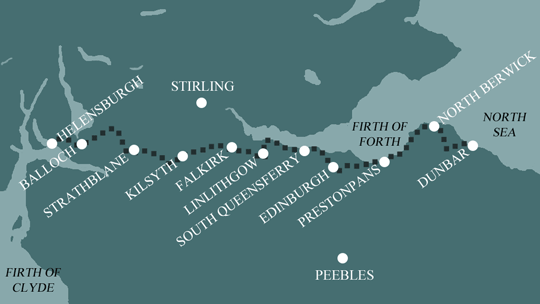John Muir Way
Helensburgh to Dunbar in 10 Days Walking Code: JM11
A rewarding coast to coast walk from Helensburgh to Dunbar, the John Muir Way blends scenic coastal trails with tranquil countryside and lively cityscapes. Walk through woodlands, farmlands, and historic towns, with plenty of time to enjoy Edinburgh’s vibrant cultural sights along the way.
There are some lengthy days on the John Muir Way, however it is generally a low level walk with moderate gradients. The longest day, 18 miles, between Balloch and Strathblane also has the highest point on the trail, albeit a mere 900 feet (275m).
| Miles | Km | ||
|---|---|---|---|
| Day 1 | Travel to Helensburgh for your first nights accommodation | ||
| Day 2 | Helensburgh to Balloch | 9 | 14 |
| Day 3 | Balloch to Strathblane | 18 | 29 |
| Day 4 | Strathblane to Kilsyth | 13 | 21 |
| Day 5 | Kilsyth to Falkirk | 13 | 21 |
| Day 6 | Falkirk to Linlithgow | 10 | 16 |
| Day 7 | Linlithgow to South Queensferry | 15 | 24 |
| Day 8 | South Queensferry to Edinburgh | 16 | 26 |
| Day 9 | Edinburgh to Prestonpans then transfer to North Berwick | 10 | 16 |
| Day 10 | Transfer back to Prestonpans then walk to North Berwick | 16 | 26 |
| Day 11 | North Berwick to Dunbar | 15 | 24 |
| Day 12 | Depart from Dunbar after breakfast |
Helensburgh to Strathblane
Fine scenery ensures a fabulous start to the John Muir Way, particularly the stunning views over the Firth of Clyde, and over Loch Lomond and its islands. Delightful sections of woodlands add to the allure.
Setting off, take time to observe the bench and stone circle inscribed with quotations from John Muir on the esplanade. On the outskirts of Helensburgh sits the fabulous Charles Rennie Mackintosh designed The Hill House, well worth a look around should time allow. Next up is the delightful reservoir, home to a variety of birdlife.
Much of the trail between Helensburgh and Balloch is spent in the woodlands of Bannachra Muir and Darleith Muir. The path through Bannachra is fairly wide and as you progress up and around the flanks of Ben Howie to Gouk Hill fine views open up over the Firth of Clyde. Signs lead to a viewpoint offering superb views over Loch Lomond.
Leaving Darleith Muir the trail descends along the old coffin road of Stoneymollan Road, with views over Ben Lomond and the islands to your left, and the Campsies and over Balloch ahead.
Beyond the town itself sits Balloch Castle. It’s here the trail turns away from Loch Lomond. Another fine stretch of plantation is enjoyed, guiding you by Tombocle Hill and through Carling Glen emerging to skirt around the shores of Burncrooks Reservoir with its impressive dam. Over the water, to the north east, is the wonderfully named hill, The Whangie. It’s a fascinating rock formation, but given the length of the Balloch to Strathblane leg, only the very strongest of walkers could factor in time for a detour. Something for another day perhaps.
Further forest track and reservoir service road lead to Auchineden Farm and beyond there the site of the Carbeth Huts. The huts date back to 1918 when working folk from Glasgow and Clydebank rented land from the Carbeth Estate and built and owned their own holiday huts. It’s a fascinating and ongoing story well worth further reading.
Next up is Carbeth Loch where the John Muir Way and the West Highland Way meet. The Way is followed northbound briefly before turning for Strathblane heading through another enjoyable patch of plantation.
Strathblane to Falkirk
Lovely walking with plenty of peaceful canalside. The Roman fort, bath-house and Antonine Wall, as well as the magnificent Falkirk Wheel provide added interest.
Leaving Strathblane the trail follows the trackbed of the dismantled Blane Valley Railway. Initially sheltered by trees, the line continues largely in the open, passing the impressive volcanic plug of Dunglass. Farmland becomes woodland and soon the trail meets with the fast-flowing Pow Burn.
Observant walkers will spot signs for the Thomas Muir Trail. The two Muirs are not connected, except for the fact that the John Muir Way shares this route all the way to Kirkintilloch.
Beyond Kirkintilloch lies the village of Twechar where signs point to Bar Hill Fort/The Antonine Wall. A rough track heads steeply uphill rewarding you with fine views of the Campsies in the north. On reaching Bar Hill Fort take time to explore the well-preserved ramparts, headquarters building and Roman baths.
The Antonine Walkway leads on to Croy Hill where you are again rewarded with glorious views. The remains of the Roman fortlet here are not immediately clear, thankfully there’s a stone interpretation board to offer help. The Antonine Wall on the other hand is clearly visible, with its ditch sharply defined.
Next comes a peaceful stretch of towpath to Wyndford Lock. Beyond the Lock the canal passes beneath the M80 motorway and crosses the old Cumbernauld Road before descending through three locks en route to Bonnybridge.
East of Bonnybridge lies Rough Castle Roman Fort and the enormous ditch of the Antonine Wall. Look out for the array of Roman pits. These remarkable defensive structures were most recently excavated in 1903.
Next is the magnificent Falkirk wheel. The wheel, the world’s first and only rotating boat lift, bridges the 115 feet gap between the Forth & Clyde Canal and the Union Canal, replacing the previous 11 locks with a huge gondola carrying up to 8 boats floating on an incredible 60 tons of water.
Falkirk to South Queensferry
A fascinating section packed full of points of interest, from the Renaissance splendour of Callendar House and the impressive Victorian Avon Aqueduct, to Blackness Castle and Hopetoun House.
Callendar Park, home to Callendar House, is the first point of interest on this section of trail. Admission is free and the chateau-like mansion, is worthy of exploration should time allow. Leaving Callendar Wood the trail joins the Union Canal towpath and heads through Polmont.
Beyond Polmont lies the impressive Avon Aqueduct, which at 810 feet long and 86 feet high, is Scotland’s longest and highest aqueduct. Enjoy the lofty views over the gorge from the towpath. Once crossed, a flight of 23 steps lead down to meet the River Avon Heritage Trail. After a time running high above the river, the trail drops down to the riverside rewarding you with fine views of the rapids and rich bird life as you make your way to Linlithgow.
Take time to explore Linlithgow Loch and perhaps even the palace too before heading north to the coast. On your way to the coast you’ll pass alongside Bo’mains Meadow Wildlife Reserve enjoying views across the Firth of Forth to Fife.
Next up is Kinneil Wood followed by James Watt’s Cottage and then Kinneil House with its museum located in the stable block. A short diversion leads to the ruins of the 12th century Kinneil Church.
Reaching the coastline the trail naturally heads east, after five miles or so arriving at the imposing ruins of Blackness Castle, before entering Wester Shore Wood, a delightful strip of oak, beech and Scots pine. This woodland leads to Hopetoun Estate where you may be lucky to spot red, roe and fallow deer. Within the 6500 acre estate is Hopetoun House, regarded as Scotland’s finest stately home. The house is open to visitors from Easter through until the end of September.
Leaving Hopetoun make your way to South Queensferry guided by the sight of the Queensferry Crossing, Forth Road Bridge and the Forth Rail Bridge.
South Queensferry to Prestonpans
Long stretches of enjoyable urban walking through the streets of Edinburgh, bookended by delightful coastal walking. There’s also the opportunity to climb the magnificent Arthur’s Seat with the reward of superb views of the city and the Firth of Forth.
Take time at South Queensferry harbour to soak up the tremendous views of the three bridges. Moving on the Way enters the woodlands of the Dalmeny Estate. Remaining on the coastline the trail passes Hound Point where a short detour leads you to a lovely picnic area where you can enjoy fantastic views over the Forth. To the south-east you’ll spot the unmistakable silhouette of Arthur’s Seat, and in the distant north-east, the cone of North Berwick Law.
Continuing along the coast you pass the imposing Dalmeny House before reaching Eagle Rock with views out to Cramond Island. Here the trail turns inland and the start of the urban walking.
Having walked through the streets of Clermiston there’s a little break from the pavements as the trail heads into Corstorphine Hill Woods, home to Clermiston Tower. The monument was built in 1871 as a memorial to Sir Walter Scott. If the tower is open, consider climbing the 101 steps to its gallery for outstanding views. Leaving the tower, head back downhill through dense woodland following the perimeter fence of Edinburgh Zoo.
The official John Muir Way now heads south west picking up the Union Canal and bypassing the city centre before entering Holyrood Park. Alternatively, you may prefer to follow the unofficial shortcut detailed in your guidebook, saving two miles while taking in the major sights of the city centre and offering an easier to climb onto Arthur’s Seat for those choosing to do so.
The trail now heads past Duddingston Loch and again follows the streets of Edinburgh to reach Fisherrow Harbour and links with its expansive sandy beach, and once again, those amazing views over the Forth to Fife. Head along the coast to Prestonpans guided by the cone of North Berwick Law.
Prestonpans to Dunbar
A good mixture of foreshore, farmland, woodland and estuary, with highlights being Aberlady Bay, the John Muir Country Park and the clifftop approach to Dunbar.
On the 21st of September 1745 Bonnie Prince Charlie’s Jacobite army defeated the government troops at the Battle of Prestonpans. Of course the eventual outcome of the campaign was less successful.
Prestonpans merges into Cockenzie and Port Seton and it’s beyond there at Seton Sands you really begin to feel you’re out into the rural countryside once again. Longniddry Bents is a delightful strip of coastal grassland and beach with wonderful plant life. By Gosford Sands you’ll pass the striking entrance to Gosford House. Completed in 1800 this neo-classical mansion was designed by Robert Adam and features an impressive three storey marble hall.
Approaching Aberlady look out for the splendid kirk. Its tower dates back to 1482, however much of the kirk was restored and rebuilt in 1887. In the 18th century Aberlady acted as a harbour for the nearby town of Haddington. On the shore here is Gullane Sands, a vast expanse of tidal mud and sand, a haven for bird life.
Leaving the coast for a time the trail heads for Gullane, home to number of golf courses including Muirfield, famous for hosting the Open Championship. Beyond Gullane lies Dirleton with its 13th century castle. The castle is open daily and makes for an enthralling visit.
Rejoining the coast there are splendid views over to Fidra, now an RSPB reserve, and quite possibly the inspiration for Robert Louis Stevenson’s Treasure Island. His cousin David Stevenson, built the island’s lighthouse in 1885. From here, appropriate footwear and tide permitting, it’s possible to head across Broad Sands and follow the shore all the way to North Berwick, however the official trail takes an inland path.
Entering North Berwick there are impressive views over the harbour out to Craigleith and over to the Bass Rock. Take time to visit the Scottish Seabird Centre.
Leaving the town the Way heads for North Berwick Law. The official trail passes alongside this volcanic lava plug. Those wishing to make the ascent of the 613 feet viewpoint should allow around 40 to 60 minutes to get up and down. Those that do will be rewarded with fabulous views in all directions.
The trail now travels south through pleasant farmland to reach the town of East Linton before turning east for the coast. Approaching the coast at Tyninghame the Way enters the John Muir Country Park and remains within it until Dunbar. The park covers an area of nearly 2000 acres and this saltmarsh, coast, grassland and woodland, is home to over 400 plant species and variety of birdlife including elder shelduck, skylark, and ringed plover.
The coast is reached at Belhaven Bay, a vast expanse of golden sand. From here the Way follows the clifftop trail into the town of Dunbar, with the ruins of its 12th century castle out on a promontory, where John Muir would scramble as a boy. Be sure to get your photograph by the John Muir Statue on the High Street.
Easy to Moderate
When walked at a comfortable pace The John Muir Way can be completed by people with limited walking experience who have a reasonable level of fitness. However, whilst not technically difficult, there are some lengthy days and you should take this into consideration when choosing this trail.
Terrain: A combination of farmland, woodland, canalside, dismantled railway, pavement and foreshore.
What’s it like underfoot? The trail makes good use of existing footpaths and towpaths, as well as some minor roads. There are extended periods of pavement walking through Edinburgh. As with any walk, farmland and woodland can become muddy after periods of heavy rain, but the paths are generally in very good condition. There are duckboards and wooden bridges in troublesome areas. Walking on the foreshore you will experience a mix of sand and grassland.
How Much Up & Down? This is generally a low level walk, with moderate gradients, and free from any serious climbs. The highest point on the trail is south of Burncrooks Reservoir which stands 900 feet (275m) above sea level. Two popular summits alongside the trail, Arthur’s Seat at 823 feet (252m) and North Berwick Law, 551 feet (168m) are both optional, and not part of the official route.
Signposting: There is dedicated John Muir Way waymarking along the route. The Way intersects with, and at times, shares paths with other routes such as the West Highland Way, the Three Lochs Way and the Thomas Muir Heritage Way. Take care at these times to ensure you remain on the correct trail.
Navigation: You should find it really straightforward. As stated above, there is dedicated John Muir Way waymarking, the guidebook is incredibly detailed with very useful advisory notes and colour mapping, and we supply a separate 1:75,000 map of the entire route. Providing you pay attention to the waymarking, and refer to your guidebook at regular intervals, you are unlikely to need map and compass skills, unless you are unfortunate enough to experience extreme poor weather.
Weather: Fingers crossed you will experience warm, dry weather throughout your holiday and enjoy dry paths and tremendous views, but you must be prepared because the weather can change quickly, especially in Scotland. Good clothing, comfortable footwear and reliable waterproofs are essential. It is important you carry plenty of water on warm days. Pack your floppy hat and sun cream also!
|
All Holidays
|
|
| Accommodation | Overnight Bed and Breakfast accommodation in selected hotels, farmhouses, village inns, guest houses and family B&Bs. Cooked or Continental breakfast. |
| Guidebook | A detailed guidebook with route information, maps, photos and background information. |
| Information of Services Along the Route | A comprehensive Service Info sheet, including services such as cash points, banks, post offices, village shops, inns, cafes and taxis. |
| Maps | A (1:75,000) map covering the whole of the John Muir Way. |
| Personal Itinerary | A personal itinerary setting out each overnight stop, including large scale maps of each accommodation, to ensure you find it easily. |
| Emergency Telephone Support | If you get in to difficulties during your holiday, we are always available to help, even out of office hours. |
|
Options
|
|
| Luggage Transport | We will transfer your luggage between each overnight stop – if you leave your luggage at the accommodation when you set off in the morning, it will be moved on to your next B&B. You only need to carry a small day sack with the clothes and provisions you require during the day’s walk. |
| Packed Lunches |
We are unable to pre book packed lunches on this route. However, some accommodations will be happy to prepare a packed lunch if requested on arrival. |
| Off Road Parking | If you are travelling by car we can usually arrange off road parking for the duration of your trip. (There may be a small charge for this). |
| Arrangement of return transport | We can also arrange your transfer back to your car, (or advise you when public transport is a better option)! |
|
What’s not Included
|
|
| Evening Meals | Your evening meal isn’t included in the package, but we include full details and recommendations for each evening meal in your itinerary. You will normally be within walking distance of a pub and/or restaurant, or where there is good food available at the accommodation, we’ll book that for you. Allow about £30.00 per night. |
| Transport to the Start & Away from the Finish | Have a look at the ‘Travel Info’ tab above for suggestions. If you’re still struggling, get in touch and we’ll help you sort it out. |
| Travel Insurance | Even if you are based in the UK travel insurance is worth having. |
Good accommodation and friendly hosts are an essential part of any holiday. We understand this and go out of our way to find the best. We put a great deal of effort into hand picking our accommodation and matching it to individual customer requirements. As well as visiting the accommodation ourselves, we ask all our customers to complete a short evaluation on each night’s accommodation, which then gives us an insight into the day-to-day operation and lets us spot any potential issues before they become a problem.
We use a variety of accommodation. Over the course of your trip you might stay in a village inn, a bed and breakfast in a converted barn, a Victorian guest house, or on a working farm. In selecting the accommodation we look for helpful, friendly hosts with good quality, characterful accommodation close to the trail. Occasionally we may use a chain hotel.
We always try to arrange en suite accommodation, i.e. rooms with their own bathrooms for each night of your stay. However, in some of the more remote locations accommodation is limited and occasionally we may have to book rooms with shared bathrooms for one or two nights of your holiday, (especially if the booking is made at short notice), but we will always let you know if this is likely to be the case.
We are happy to book single rooms on our holidays but cannot normally book more than two for any one group. Single room bookings include a supplement.
Here are some examples of the accommodation we use on the John Muir Way:
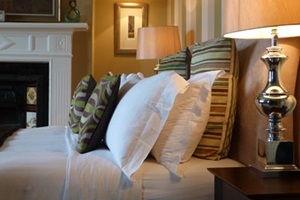 You are assured of a very warm welcome at No. 20 Boutique B&B in Helensburgh. This award winning establishment prides itself on attention to detail and their three luxurious rooms are certainly testament to that. This is the ideal place to take it easy and admire the estuary sea views before setting off on your John Muir Way adventure. Visit their website
You are assured of a very warm welcome at No. 20 Boutique B&B in Helensburgh. This award winning establishment prides itself on attention to detail and their three luxurious rooms are certainly testament to that. This is the ideal place to take it easy and admire the estuary sea views before setting off on your John Muir Way adventure. Visit their website
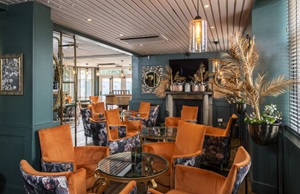 At the foot of the magnificent Campsie Hills in the charming village of Strathblane is the Kirkhouse Inn. This historic hotel and restaurant dates back to 1601 when it was a tavern and stables. A popular choice with outdoor enthusiasts, it has naturally enjoyed some refurbishments, but has retained all of its traditional country atmosphere. Visit their website
At the foot of the magnificent Campsie Hills in the charming village of Strathblane is the Kirkhouse Inn. This historic hotel and restaurant dates back to 1601 when it was a tavern and stables. A popular choice with outdoor enthusiasts, it has naturally enjoyed some refurbishments, but has retained all of its traditional country atmosphere. Visit their website
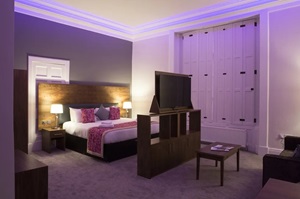 In the centre of historic Linlithgow is the stylish Court Residence. This former county court house is now home to luxurious suites. Whilst retaining period features from its 150 years as a court, it also provides every modern comfort for your convenience, from colour-changing mood lighting to sunken baths and wet-room rainfall showers. Visit their website
In the centre of historic Linlithgow is the stylish Court Residence. This former county court house is now home to luxurious suites. Whilst retaining period features from its 150 years as a court, it also provides every modern comfort for your convenience, from colour-changing mood lighting to sunken baths and wet-room rainfall showers. Visit their website
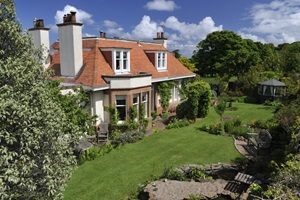 Located in the picturesque seaside town of North Berwick is Glengair Bed & Breakfast, a charming Edwardian family house set in a lovely garden. It’s just a two minute walk to the High Street with its delightful shops and restaurants. A further two minutes and you’ll arrive at the beautiful beaches and the harbour with views out to the Bass Rock. Visit their website
Located in the picturesque seaside town of North Berwick is Glengair Bed & Breakfast, a charming Edwardian family house set in a lovely garden. It’s just a two minute walk to the High Street with its delightful shops and restaurants. A further two minutes and you’ll arrive at the beautiful beaches and the harbour with views out to the Bass Rock. Visit their website
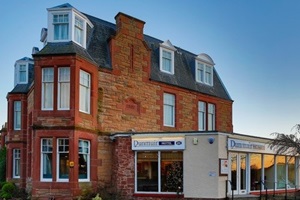 A warm welcome awaits you at the Dunmuir Hotel & Restaurant in Dunbar. This award-winning family hotel is home to the 1902 Bar & Grill restaurant, the perfect place to celebrate completing the trail. Dating back to 1902, this elegant building has been upgraded to a high modern standard whilst preserving many of the original features. Visit their website
A warm welcome awaits you at the Dunmuir Hotel & Restaurant in Dunbar. This award-winning family hotel is home to the 1902 Bar & Grill restaurant, the perfect place to celebrate completing the trail. Dating back to 1902, this elegant building has been upgraded to a high modern standard whilst preserving many of the original features. Visit their website
General travel information for the John Muir Way will be in your holiday pack.
Detailed instructions on getting to your first night’s accommodation by car, or on foot from the nearest train or bus station, will also be included in the holiday pack on individual accommodation maps.
To view train times please visit trainline where you can also purchase tickets in advance. For information on bus timetables please visit traveline
Getting to Helensburgh:
By Air: The nearest International Airport to the trail is Glasgow. Buses run regularly between Glasgow Airport and Queen Street Railway Station.
By Public Transport: Trains run between Glasgow Queen Street and Helensburgh Central. Glasgow Queen Street and Glasgow Central have connecting trains.
By Road: Helensburgh is located on the A818, 5 miles east of Arden on the A82 Glasgow to Inverness road.
Returning from Dunbar:
By Public Transport: Dunbar Railway Station is located on the East Coast Main Line between Edinburgh Waverley and London Kings Cross.
By Road: Dunbar is located on the A1087, just off the A1 Edinburgh to London road.
Balloch
Despite only being one day into the John Muir Way, Balloch, often referred to as the gateway to the Loch Lomond & The Trossachs National Park, is worthy of consideration for an additional day of exploration.
Take a walk through the picturesque Balloch Castle Country Park. This fabulous space comprises 200 acres of semi-natural and ornamental woodland, formal gardens, meadow and shoreline.
Enjoy indoor, outdoor and water-based activities as well as great shopping and dining at Loch Lomond Shores, a stunning visitor destination home to Loch Lomond Sea Life Aquarium. Bike, pedal boat, segway and canoe hire services are available.
Treezone is the ultimate aerial adventure course, featuring zip wires, balance beams, hanging platforms, scramble nets and much, much more. If you’d prefer a more relaxing tree top experience why not visit Loch Lomond Bird of Prey Centre where you can observe birds of prey close up in magnificent surroundings.
Linlithgow
Located midway between Falkirk and Edinburgh, the ancient burgh of Linlithgow is best known for its Palace, the birthplace of Mary Queen of Scots. The impressive 15th century ruin is perfectly positioned by Linlithgow Loch. Mary Queen of Scots was born here on the 8th of December 1542, and just six days later, following the death of her father, King James V of Scotland, she became Queen.
Visit the Linlithgow Canal Centre and take an afternoon boat trip over the magnificent Avon Aqueduct in St Magdalene, a 40 seater canal boat. Trips available Saturday and Sunday. Alternatively, enjoy a half hour trip out on Victoria, diesel powered replica of a Victorian steam packet boat. Trips run Saturday and Sunday as well as weekdays throughout July and August. While there take time to visit Scotland's only Canal Museum and enjoy delicious refreshments in the tea room.
Edinburgh
Scotland’s Capital needs little introduction. With its stunning architecture, intriguing narrow streets and awe-inspiring castle which just happens to be perched on a dormant volcano, an additional day exploring Edinburgh must surely be on everyone’s wish list. There’s an endless list of exciting things to see and do. By day you can visit museums and galleries, explore the famous Royal Mile and Princess Street, and by night, enjoy musical performances, theatre and fine dining.
Just some of the sights you might consider exploring include the National Museum of Scotland, Camera Obscura and World of Illusion, Scottish National Gallery of Modern Art, Lauriston Castle and Gardens, the National Monument on Calton Hill, Edinburgh Dungeons, Our Dynamic Earth and of course, Edinburgh Castle.
Dunbar
Having walked the John Muir Way why not celebrate by rewarding yourself with a rest day in the birthplace of the great man himself.
Dunbar is steeped in history and in the middle ages was one of the most important Scottish Fortresses. The ruins of its 12th century castle out on a promontory by the harbour, where John Muir would scramble as a boy, once sheltered Mary Queen of Scots when she fled Edinburgh after the murder of David Rizzio in the Palace of Holyrood house.
Dunbar’s high street has a number of unique local businesses as well as award winning food and drink establishments.
Blue Wild Nature Boat Tours provide trips to the Bass Rock with its 150,000 northern gannets, and to the Isle of May, home to one of the UK’s largest island puffin colonies, 200,000 migrant birds, seals and Stevenson’s lighthouse. Keen photographers may be interested to take one of their sunrise or sunset tours.
| Prices | GBP (£) |
|---|---|
| Accommodation, map & guidebook only | £1388 |
| with Luggage Transport | £1553 |
Other Options |
|
| Extra Nights (per night) | £95 |
| Single Supplement (per night) | £69 |
| Solo Luggage Supplement (per day) | £16 |
